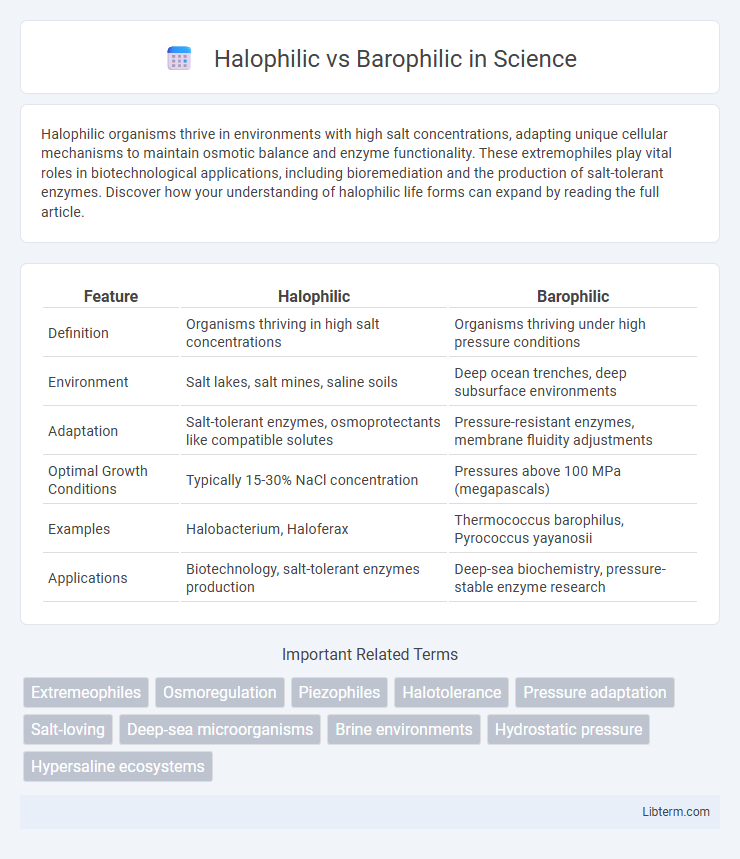Halophilic organisms thrive in environments with high salt concentrations, adapting unique cellular mechanisms to maintain osmotic balance and enzyme functionality. These extremophiles play vital roles in biotechnological applications, including bioremediation and the production of salt-tolerant enzymes. Discover how your understanding of halophilic life forms can expand by reading the full article.
Table of Comparison
| Feature | Halophilic | Barophilic |
|---|---|---|
| Definition | Organisms thriving in high salt concentrations | Organisms thriving under high pressure conditions |
| Environment | Salt lakes, salt mines, saline soils | Deep ocean trenches, deep subsurface environments |
| Adaptation | Salt-tolerant enzymes, osmoprotectants like compatible solutes | Pressure-resistant enzymes, membrane fluidity adjustments |
| Optimal Growth Conditions | Typically 15-30% NaCl concentration | Pressures above 100 MPa (megapascals) |
| Examples | Halobacterium, Haloferax | Thermococcus barophilus, Pyrococcus yayanosii |
| Applications | Biotechnology, salt-tolerant enzymes production | Deep-sea biochemistry, pressure-stable enzyme research |
Introduction to Extremophiles
Halophilic organisms thrive in environments with high salt concentrations, adapting specialized cellular mechanisms to maintain osmotic balance and enzyme function. Barophilic extremophiles, also known as piezophiles, survive and grow optimally under extreme hydrostatic pressures found in deep-sea habitats, utilizing pressure-resistant membrane structures and proteins. Both halophiles and barophiles represent diverse adaptations within extremophiles, highlighting the remarkable evolutionary strategies life employs to endure harsh environmental conditions.
Defining Halophilic Microorganisms
Halophilic microorganisms thrive in environments with high salt concentrations, often exceeding 3% NaCl, and possess specialized cellular mechanisms like compatible solute accumulation to maintain osmotic balance. These extremophiles include archaea, bacteria, and some eukaryotic species, playing crucial roles in saline ecosystems such as salt lakes, salt mines, and marine environments. Unlike barophilic microorganisms, which are adapted to high-pressure conditions found in deep-sea habitats, halophiles are primarily defined by their salt tolerance and metabolic adaptations to hypersaline conditions.
Characteristics of Barophilic Organisms
Barophilic organisms thrive in high-pressure environments, such as deep ocean trenches, exhibiting cellular adaptations like increased membrane fluidity and specialized enzyme structures to maintain functionality under extreme pressure. Their proteins possess unique conformations that prevent denaturation, while their metabolic pathways are optimized for efficient energy production despite the pressure challenges. Unlike halophilic organisms that adapt to high salt concentrations, barophiles demonstrate resilience primarily through structural and biochemical modifications attuned to deep-sea hydrostatic pressure conditions.
Environmental Niches: Salt vs. Pressure
Halophilic organisms thrive in environments with high salt concentrations, such as salt lakes, saline soils, and salt mines, adapting their cellular mechanisms to maintain osmotic balance. Barophilic organisms inhabit high-pressure environments like deep-sea trenches and oceanic crust, evolving proteins and membranes that remain functional under extreme hydrostatic pressure. These distinct environmental niches drive specialized adaptations that enable survival in either hypersaline or high-pressure habitats.
Adaptation Mechanisms in Halophiles
Halophiles adapt to high-salinity environments through the accumulation of compatible solutes like potassium chloride and synthesis of osmoprotectants such as glycine betaine, enabling cellular osmotic balance. Their proteins exhibit structural modifications to maintain stability and functionality in hypersaline conditions by enhancing surface charge and hydration shells. Membrane adaptations include increased lipid saturation and unique phospholipid compositions to preserve membrane integrity under extreme ionic stress.
Survival Strategies of Barophiles
Barophiles, also known as piezophiles, survive in extreme high-pressure environments by adapting their cellular structures, such as incorporating unsaturated fatty acids into their membranes to maintain fluidity under pressure. They optimize protein folding and enzyme function to withstand compression, ensuring metabolic processes remain efficient. These specialized adaptations distinguish barophiles from halophiles, which thrive primarily through osmoregulatory mechanisms in high-salt habitats.
Physiological Differences: Halophiles vs. Barophiles
Halophiles thrive in high-salt environments by maintaining osmotic balance through the accumulation of compatible solutes or specialized ion pumps, enabling cellular function under extreme salinity. Barophiles adapt to high-pressure conditions by modifying membrane lipid composition to preserve fluidity and stabilizing proteins with pressure-resistant folding mechanisms. These physiological adaptations highlight distinct survival strategies where halophiles focus on osmotic regulation, whereas barophiles optimize structural stability against intense hydrostatic pressure.
Industrial and Biotechnological Applications
Halophilic microorganisms thrive in high-salt environments and are utilized in industrial processes such as bioremediation of saline wastewaters and production of salt-tolerant enzymes for pharmaceuticals and food industries. Barophilic organisms, adapted to high-pressure conditions in deep-sea habitats, offer unique enzymes and biomolecules for biotechnological applications including the synthesis of pressure-stable biocatalysts and novel marine-derived pharmaceuticals. Both extremophiles provide valuable bioresources for enhancing bioprocess efficiency under harsh industrial conditions.
Ecological Significance and Environmental Impact
Halophilic organisms thrive in high-salt environments such as salt lakes and saline soils, playing a crucial role in biogeochemical cycles by facilitating nutrient turnover and supporting unique microbial ecosystems. Barophilic microorganisms inhabit high-pressure environments like deep-sea trenches, influencing organic matter decomposition and contributing to carbon cycling in extreme habitats. Both extremophiles drive ecological balance by sustaining specialized food webs and impacting global processes such as bioremediation and elemental fluxes in their respective environments.
Future Directions in Extremophile Research
Future directions in extremophile research emphasize the genetic and metabolic adaptations of halophilic and barophilic microorganisms to unlock novel biotechnological applications, including bioengineering enzymes for high-salinity and high-pressure industrial processes. Advancements in metagenomics and synthetic biology enable detailed mapping of osmoadaptation and piezotolerance pathways, enhancing biosynthesis of extremozymes and biomolecules tailored for environmental and pharmaceutical uses. Exploring combined environmental stress responses promises innovative bioproducts and sustainable solutions in astrobiology, bioremediation, and bioenergy sectors.
Halophilic Infographic

 libterm.com
libterm.com